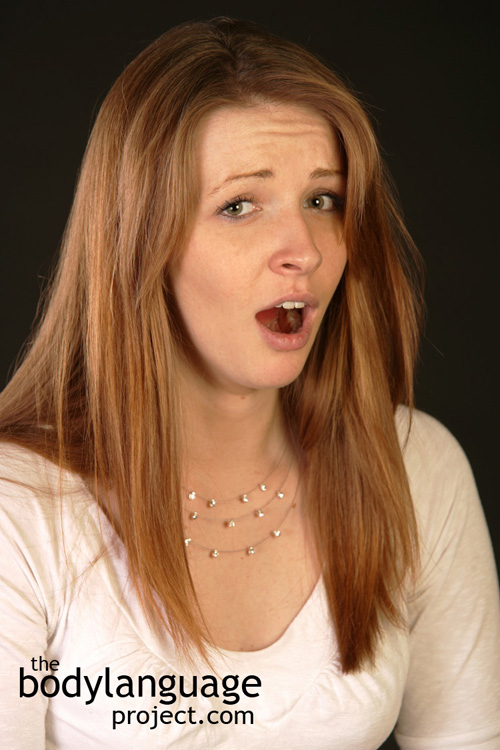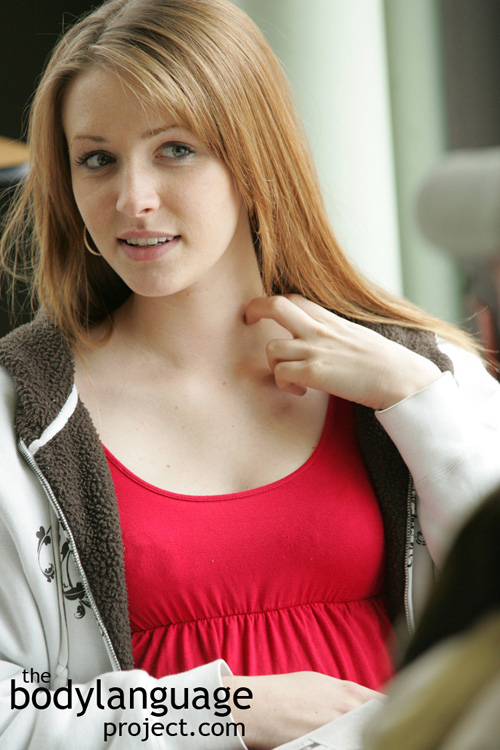Body Language of Surprised Facial Expression
 Cue: Surprised Facial Expression.
Cue: Surprised Facial Expression.
Synonym(s): N/A
Description: The eyebrows curve upwards, wrinkles form in the forehead and the whites of the eyes become visible through eye widening. The jaw becomes slack and opens.
In One Sentence: The surprised facial expression is one of the six main universal facial expressions.
How To Use it: Use the surprised facial expression to show others that they have taken you by surprise. This may be in a shared joke, to show your amazement for their accomplishments or other good or novel news. Facial expressions are a way that we can bond with other people either in positive or negative ways. Suiting our expression with our underlying attitude or conversely feigning an attitude can help create desired relationships and outcomes.
Context: General.
Verbal Translation: “I’m surprised so my face is shooting open and everything is widening.”
Variant: See Anger Facial Expression, Happiness and Joy, Sadness Facial Expression, Fearful Facial Expression, Disgust Facial Expression.
Cue In Action: The prank team set up shop in a street garbage pail while the camera was hidden around the corner. As the man sprung up, the action was captured on film. Faces shot open, mouth agape, eyebrows up – surprise!
Meaning and/or Motivation: Surprise is one of the six main facial expressions that are found throughout the world. They are happiness, sadness, surprise, fear, anger and disgust.
Each expression involves three independent parts of the face, the forehead and eyebrows, the eyes, eyelids and upper part of the nose called the “root” and the lower part of the face including the lower part of the nose, cheeks, chin and mouth.
Surprise is motivated by a fear response. Surprise implies that one is not expecting something to occur. Thus, the body and limbic system reach overdrive to open the face up to prepare it for action.
Cue Cluster: Arms usually shoot up or out, an audible squeal, scream, or “ahhh”, or gasp, is heard and the person might jump, step back, duck and head cover. Sometimes the head drops as does the jaw especially if coupled with disbelief.
Body Language Category: Arousal, Automatic gesture, Emotional body language, Excited body language, Inborn behaviours, Leaked or involuntary body language, Surprised body language, Universal facial expressions.
Resources:
Bard, K. A. (2003). Development of emotional expressions in chimpanzees (Pan troglodytes). In P. Ekman, J. Campos, R. J. Davidson & F. B. M. De Waal (Eds.), Emotions inside out: 130 years after Darwin’s The Expression of the Emotions in Man and Animals (Vol. 1000, pp. 88-90). New York: Annals of the New York Academy of Sciences.
Baron, R. M., & Kenny, D. A. (1986). The moderator-mediator variable distinction in social psychological research: Conceptual, strategic, and statistical considerations. Journal of Personality and Social Psychology, 51(6), 1173-1882.
Biehl, M., Matsumoto, D., Ekman, P., Hearn, V., Heider, K., Kudoh, T., et al. (1997). Matsumoto and Ekman’s Japanese and Caucasian Facial Expressions of Emotion (JACFEE): Reliability Data and Cross-National Differences. Journal of Nonverbal Behavior, 21, 3-21.
Carroll E. 1994. Innate and universal facial expressions: Evidence from developmental and cross-cultural research Izard, Psychological Bulletin. 115(2): 288-299.
Daniel H. Lee, Reza Mirza, John G. Flanagan and Adam K. Anderson. Optical Origins of Opposing Facial Expression Actions. Psychological Science published online 24 January 2014 DOI: 10.1177/0956797613514451
http://bodylanguageproject.com/articles/eyes-and-facial-expressions-may-be-biologically-controlled-serve-a-real-non-emotional-purpose-says-research/
de Waal, F. B. M. (2003). Darwin’s legacy and the study of primate visual communication. In P. Ekman, J. Campos, R. J. Davidson & F. B. M. De Waal (Eds.), Emotions inside out: 130 years after Darwin’s The Expression of Emotion in Man and Animals (pp. 7-31). New York: New York Academy of Sciences.
Duan, Xujun ; Dai, Qian ; Gong, Qiyong ; Chen, Huafu. Neural mechanism of unconscious perception of surprised facial expression. NeuroImage. 2010. 52(1): 401-407.
e Charlesworth, W. R. (1964). Instigation and maintenance of curiosity behavior as a function of surprise versus novel and familiar stimuli. Child Development, 35, 1169–1186.
Ekman, Paul. 1994. Strong evidence for universals in facial expressions: A reply to Russell’s mistaken critique Psychological Bulletin. 115(2): 268-287.
Ekman, Paul. 1986. A new pan-cultural facial expression of emotion. Source: Motivation and Emotion Ekman. 10(2): 159-168.
Ekman, Paul and Friesen, W. V. 1987. Universals and cultural differences in the judgments of facial expressions of emotion. Journal of Personality and Social Psychology. 53(4): 712-717.
Ekman, Paul; Friesen, Wallace V. 1971. Constants across cultures in the face and emotion. Journal of Personality and Social Psychology. 17(2): 124-129.
Ekman, Paul. 1972. Universals and cultural differences in facial expressions of emotion. In J. Cole (Ed.), Nebraska Symposium on Motivation, 1971. 19: 207-282. Lincoln: University of Nebraska Press.
Ekman, P., Levenson, R. W., & Friesen, W. V. (1983). Autonomic nervous system activity distinguishes among emotions. Science, 221(4616), 1208-1210.
Ekman, P., O’Sullivan, M., & Matsumoto, D. (1991a). Confusions about context in the judgment of facial expression: A reply to “The contempt expression and the relativity thesis.”. Motivation & Emotion, 15(2), 169-176.
Ekman, P., O’Sullivan, M., & Matsumoto, D. (1991b). Contradictions in the study of contempt: What’s it all about? Reply to Russell. Motivation & Emotion, 15(4), 293-296.
Elfenbein, H. A., & Ambady, N. (2002). On the universality and cultural specificity of emotion recognition: A meta-analysis. Psychological Bulletin, 128(2), 205-235.
Ekman, P. & O’Sullivan, M. (1991). Who can catch a liar? American Psychologist. 46, 913-920.
Fulcher, J. S. “Voluntary” facial expression in blind and seeing children. Archives of Psychology, 1942. 38: 272.
Friesen, W. V. 1972. Cultural differences in facial expressions in a social situation: An experimental test of the concept of display rules. Unpublished doctoral dissertation, University of California, San Francisco.
James A. Russell, Naoto Suzuki and Noriko Ishida. 1993. Canadian, Greek, and Japanese freely produced emotion labels for facial expressions. Motivation and Emotion. 17(4): 337 -351
Russell, James A. 1995. Facial Expressions of Emotion: What Lies Beyond Minimal Universality? Psychological bulletin. 118(3): 379-391.
Russell, James A. 1994. Is There Universal Recognition of Emotion From Facial Expression? A Review of the Cross-Cultural Studies. Psychological Bulletin. 115(1): 102-141.
Susskind, Joshua M and Adam K Anderson. Facial Expression Form and Function. Communicative Integrative Biology. 2008. 1(2): 148–149. PMCID: PMC2686004
http://bodylanguageproject.com/articles/emotional-facial-expressions-evolve/
Levenson, R. W., Ekman, P., & Friesen, W. V. (1990). Voluntary facial action generates emotion-specific autonomic nervous system activity. Psychophysiology, 27(4), 363-384.
Levenson, R. W., Ekman, P., Heider, K., & Friesen, W. V. (1992). Emotion and autonomic nervous system activity in the Minangkabau of West Sumatra. Journal of Personality & Social Psychology, 62(6), 972-988.
Ludden, G. D. S., Schifferstein, H. N. J., & Hekkert, P. (2009). Visual–tactual incongruities in products as sources of surprise. Empirical Studies of the Arts, 27, 63–89.
Matsumoto, D. (1989). Cultural influences on the perception of emotion. Journal of Cross-Cultural Psychology, 20(1), 92-105.
Matsumoto, D. (1992). American-Japanese cultural differences in the recognition of universal facial expressions. Journal of Cross-Cultural Psychology, 23(1), 72-84.
Matsumoto, D. (2001). Culture and Emotion. In D. Matsumoto (Ed.), The Handbook of Culture and Psychology (pp. 171-194). New York: Oxford University Press.
Matsumoto, D., & Ekman, P. (1989). American-Japanese cultural differences in intensity ratings of facial expressions of emotion. Motivation & Emotion, 13(2), 143-157.
Matsumoto, D., Keltner, D., Shiota, M. N., Frank, M. G., & O’Sullivan, M. (2008). What’s in a face? Facial expressions as signals of discrete emotions. In M. Lewis, J. M. Haviland & L. Feldman Barrett (Eds.), Handbook of emotions (pp. 211-234). New York: Guilford Press.
Matsumoto, D., & Willingham, B. (2009). Spontaneous Facial Expressions of Emotion of Congenitally and Non-Congenitally Blind Individuals. Journal of Personality and Social Psychology, 96(1), 1-10.
Mesquita, B., & Frijda, N. H. (1992). Cultural variations in emotions: A review. Psychological Bulletin, 112, 197-204.
McClure, Erin B 2000. A meta-analytic review of sex differences in facial expression processing and their development in infants, children, and adolescents
Psychological Bulletin. 126(3): 424-453.
Mead, M. 1975. Review of “Darwin and facial expression.” Journal of Communication, 25: 209-213.
Peleg, G., Katzir, G., Peleg, O., Kamara, M., Brodsky, L., Hel-Or, H., et al. (2006). Heriditary family signature of facial expression. Proceedings from the National Academy of Sciences, 103(43), 15921-15926.
Reisenzein, R. (2000). Exploring the strength of association between the components of emotion syndromes: the case of surprise. Cognition and Emotion, 14, 1–38.
Parzuchowski, Michal ; Szymkow-Sudziarska, Aleksandra. Well, slap my thigh: expression of surprise facilitates memory of surprising material. Emotion. 2008. 8(3): 430-4.
Reisenzein, R., Bördgen, S., Holtbernd, T., & Matz, D. (2006). Evidence for strong dissociation between emotion and facial displays: the case of surprise. Journal of Personality and Social Psychology, 91, 295–315.
Reisenzein, R., & Studtmann, M. (2007). On the expression and experience of surprise: no evidence for facial feedback, but evidence for a reverse self-inference effect. Emotion, 7, 612–627.
Scherer, K. R., Zentner, M. R., & Stern, D. (2004). Beyond surprise: the puzzle of infants’ expressive reactions to expectancy violation. Emotion, 4, 389–402.
Schützwohl, Achim ; Reisenzein, Rainer. Facial expressions in response to a highly surprising event exceeding the field of vision: a test of Darwin’s theory of surprise. Evolution and Human Behavior. 2012. 33(6): 657-664.
Vrticka, Pascal ; Lordier, Lara ; Bediou, Benoît ; Sander, David Desteno, David (editor). Human Amygdala Response to Dynamic Facial Expressions of Positive and Negative Surprise. Emotion. 2014. 14(1): 161-169.
Vanhamme, J. (2000). The link between surprise and satisfaction: an exploratory research on how to best measure surprise. Journal of Marketing Management, 16, 565–582.



